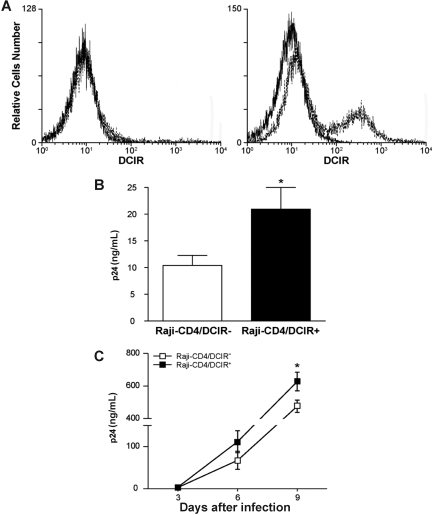Figure 6.
DCIR expression in Raji-CD4 increases HIV-1 binding and virus production. (A) Raji-CD4 cells were nucleofected with either an empty control vector (left panel) or a mammalian expression vector coding for human DCIR (right panel). Five hours later, flow cytometric analysis of DCIR was performed using a combination of PE-labeled anti-DCIR Ab (dotted lines) and a control Ab (continuous lines). Data shown correspond to a single experiment representative of 7 independent experiments. (B) Parental (DCIR-negative) and DCIR-expressing Raji-CD4 (3 × 106 cells) were exposed to NL4–3 (300 ng p24) for 60 minutes at 37°C. After 3 washes with PBS to remove unabsorbed virus, cell-associated virus was quantified by measuring the p24 content. Data shown correspond to the means plus or minus SD of triplicate samples from 7 combined independent experiments. The asterisk denotes statistically significant data (*P < .05). (C) Parental (DCIR-negative) and DCIR-expressing Raji-CD4 (1.5 × 105 cells) were exposed to NL4–3 (1.5 ng p24) for 2 hours at 37°C. After 3 washes with PBS to remove excess virus, cells were maintained in culture. Cell-free culture supernatants were collected at the indicated time points and assayed for the p24 content. Data shown correspond to the means plus or minus SD of triplicate samples from 3 combined independent experiments. The asterisk denotes statistically significant data (*P < .05).

